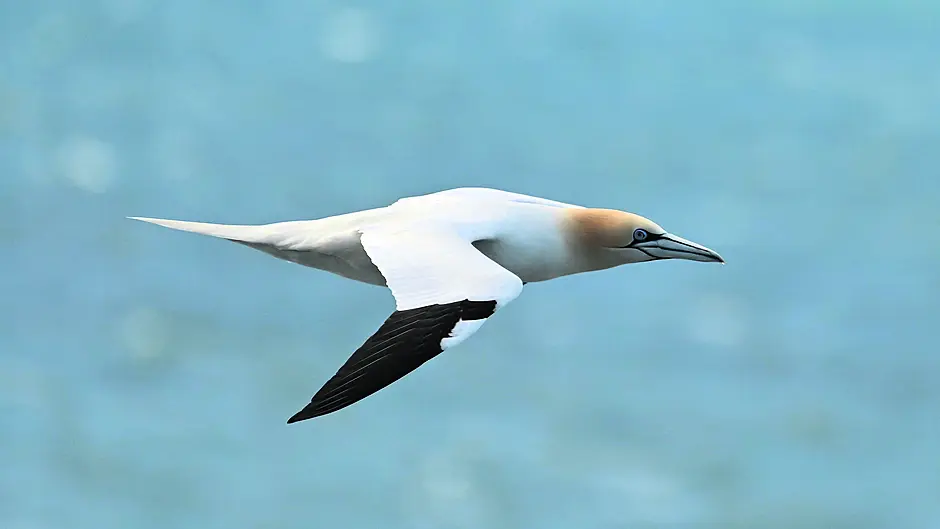WHALE watching has been the big wildlife story here in West Cork over the past month, with humpback and minke whales putting in appearances. Many of us have been gazing out to sea, or heading out on boats, hoping to get a glimpse of these magnificent beasts.
If you have been lucky enough to spot a feeding whale, you will likely also have seen gannets in action. When fish are threatened by predators, such as whales or dolphins, they often come together to form tightly packed spheres known as bait balls. While the whales feed, the magnificent gannets take advantage of these fish aggregations and can be spotted diving into the water to feed. While whales are surely the main attraction, gannets in action are also a spectacle to behold.
Recognising gannets
The northern gannet, more commonly referred to as just the gannet, is a large seabird.
Adults are white with pale yellow heads, long necks, sharp pointed beaks, black wingtips and an impressive two-metre wingspan when in flight. Immature gannets are initially brown and transition to their adult colour by 4-5 years of age, when they begin to breed.
They are striking birds – quite literally. This is because they are best known for their impressive plunge-diving. They plunge from heights of 30-40 metres straight down to the surface of the sea, folding their wings back so they are shaped like a dart. They reach speeds of up to 100 km/hr as they strike the water and reach average depths of 20m to catch a fish. Their anatomy is specifically designed to facilitate this diving behaviour, with a robust skull and strong neck muscles. In addition, to help cushion the impact as they plunge into the water, they have protective air-sacs between their muscles and skin. This reminds me of the airbags in a car and it appears that wildlife thought of this idea first.
Romance isn’t dead
Gannets are found around the entire Irish coastline. They are true seabirds, not even coming to land to roost and instead sleep out on the sea. However, every year the breeding population do come to land to breed, with females laying a single egg, usually in April. They aggregate in crowded breeding colonies, known as gannetries and these are a stimulation for the senses. The colonies involve the sight of a huge mass of large white birds, the raucous sound of their calls combined with the strong smell of their fishy diet and droppings, the latter being detectable in the air from some distance away.
Ireland’s most important gannetries are located on Great Saltee, Co Wexford, the Bull Rock, Co Cork, Ireland’s Eye, Co Dublin and on the largest one on Little Skellig in Co.Kerry.
Gannets have a fierce appearance and do fight aggressively with rivals for females and nesting territory. They are monogamous and mate for life, with pairs forming a strong bond. They have a special greeting ritual they conduct each time they have been apart. The two birds stand breast to breast, spread their wings and extend and entwine their necks while calling loudly. The male shakes and bows his head and the female offers her neck for the male to nibble. They also perform a mating ‘dance’ together as a prelude to reproduction,
Threats
Gannets have an amber conservation status, according to BirdWatch Ireland. Their population numbers are threatened by the usual list of pressures: Diminishing fish levels due to climate change and overfishing, ocean pollution, disease, and getting caught as by-catch in commercial fishing.
One study, published in 2021, showed that gannet nests in France and Italy were made up of 58% litter, with only 42% of the nesting material being of natural origin. Photos taken at nesting colonies in Ireland, such as the Skelligs, sadly show a similar situation here.
Ocean litter is an entanglement risk to gannets, causing many birds to starve because they cannot fly and dive effectively. Additionally, the effects of the chemicals released by plastic in the birds’ nests and diet are not fully understood, and initial research suggest there could be negative long-term consequences.
Bird flu
A specific, serious and ongoing threat to gannets is bird flu (H5N1 avian influenza ). This particularly impacts gannets because disease spread is facilitated when they crowd together at their breeding colonies. It is advised that if dead seabirds are spotted along the coast that we should avoid, keep ourselves, children, and pets away from them and report the finding to the Department of Agriculture, Food and the Marine.
Only last month, some strange and possibly hopeful news broke in this area. Gannets normally have pale blue eyes which are ringed by darker blue skin. A study conducted at the Bass Rock gannet colony in the UK showed that birds were able to recover from the viral infection and a sign of recovery was that their eyes had turned black, instead of the usual pale blue.
Conservationists do not yet know the full extent of bird flu’s impact on gannets and are still studying whether this will impact their future. This latest research showing recovery in some birds is at least a hopeful sign that we will be able to continue to observe these beautiful birds.
NORTHERN GANNET FACTS
Latin name: Morus bassanus
Irish name: Gainéad
Weight : 2.5 - 3.5 kg
Length: Up to 1 metre
Wingspan: Up to 2 metres
Diet: Fish such as herring and mackerel
Average lifespan: 17 years
Breeding age: from 4-5 years
Oldest known bird: 37.5 years
Number of eggs laid per nest: 1
•Ann Haigh MVB MSc MRCVS is a Skibbereen resident, a mum-of-two, and a veterinarian with a masters degree in wildlife and conservation and she is passionate about biodiversity and
nature.










